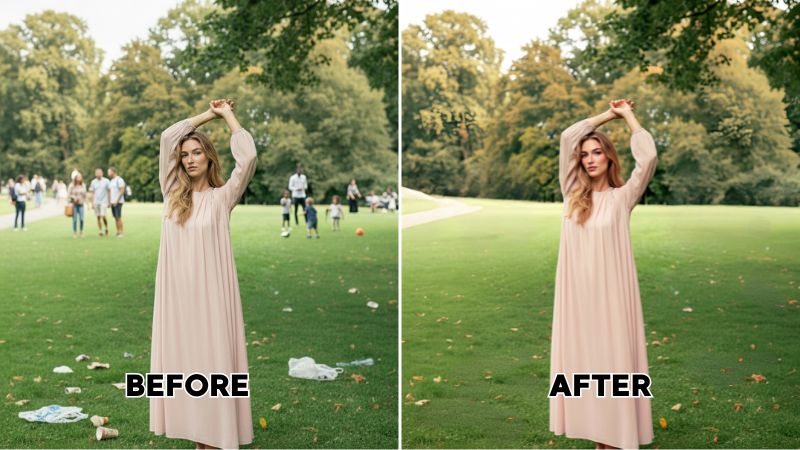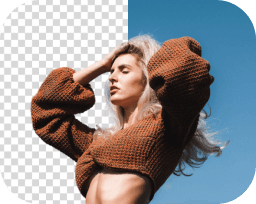
As mobile cameras and photo editing apps upgrade by the day, the need for photo editing tools and software for PCs has become somewhat obsolete. Today, it’s mostly used by professional editors who value precision, control, and the ability to fine-tune every detail all while willing to pay hefty subscriptions or license fees. However, you don’t have to spend a pretty penny to get similar results, as free photo editors for PCs and Macs are catching up. If you find yourself in need of professional-looking results without expensive tools or third-party services, here are 5 of the best photo editing software for PC that you can access and use for absolutely free.
5 Free Photo Editors for PC & Mac You Need to Try
Here is a deeper look into some of the best software for photo editing to help you deliver high-quality results without the price tag.
AirBrush Studio

AirBrush Studio is the desktop version of the popular mobile app and comes packed with all the functions users have grown to love. As one of the most competent free photo editors available today, it gives casual users a professional editing experience without the complexity of advanced software.
Both Mac and Windows users can enjoy its plain sailing photo editing features. AirBrush Studio allows expert retouching while maintaining natural textures, portrait editing, and advanced AI tools for results that are rivalled only by some of the top-performing paid tools out there, and it does all of it for free.
In my experience, the interface is highly intuitive, and the tool itself is powerful yet lightweight, which further enhances its speed and responsiveness. It is ideal for influencers, brands, and even professional photographers just starting out.
Pros
- User-friendly interface and easy one-click editing tools that allow you to make instant changes.
- It provides users with advanced beauty touch-ups such as skin smoothing, blemish removal, liquify and reshaping for a studio-like result.
- It comes with an AI spot healing and magic removal capable of erasing areas and objects alike in different variations to give you a polished finish.
- It features a complete panel for color adjustment and AI filters with varying intensities that give you more control over the look and feel of your photo.
- Exports without watermarks.
- Allows you to export your project quickly and comes with social media optimization presets so you can edit to post easily.
- It is excellent for beginners or anyone with any level of editing expertise.
Cons
- Specialized primarily for portrait enhancement
GIMP

GIMP is the one open-source photo editor that the online communities worldwide swear by. While it doesn’t position itself alongside the usual free photo editors built for simple tweaks, it delivers a far deeper, more advanced editing environment, and is equally compatible across Linux, macOS, and Windows. Right off the bat, the learning curve is quite apparent, but once you’ve got the hang of it, it rewards you with professional-level, free of cost editing.
This makes it a fairly capable alternative to many of the refined, paid editors in the market, especially ideal for photographers, designers, and artists who want full control of their projects without having to pay any substantial fees.
Pros
- Completely free and open-source, with no restrictions on any features, making it the most accessible free photo editor on this list.
- It has a customizable interface, and you can remap shortcuts to suit your editing routines or preferences, like how you would organise your workstation.
- GIMP is lightweight; therefore, installation is easy for older model computers such as Windows 7 or earlier Mac versions.
- The automation is scriptable, meaning you can automate repetitive editing tasks through Python-Fu and the BIMP plugin
- There is an active and supportive online community with extensive documentation for guidance.
Cons
- There’s no direct RAW file editing.
- There are no AI tools, such as sky replacement or context-aware auto-fill.
- There is limited CMYK and print color management.
- The interface is somewhat outdated compared to modern designs, and it takes a while to get used to.
- There are no layers for non-destructive editing, meaning all changes are done directly on the photo instead of in a layer above it.
Canva

The name Canva does not need an introduction, as over the years, since its launch, it has become synonymous with accessible design. While it’s slightly different from typical free photo editors, its free version can still be of immense use to marketers, influencers, and small business owners to create polished content in minutes.
I was particularly impressed by its AI-assisted tools, multiple-device compatibility, and a responsive collaborative workspace that makes it a staple for group projects. It is most famously known for its library of templates, which makes Canva a quick fix for anyone looking to create template-driven designs.
Pros
- Very beginner-friendly as it has a minimal learning curve and a very clean interface.
- There are thousands of customizable templates and designs for use or to get ideas for your own designs.
- You get access to AI features such as Magic Media or Background Remover, and it is the best AI software for photo editing.
- You can give access to others and collaborate in real-time with your friends/teammates.
- It works directly from the browser and doesn’t require any installation, but it does require you to make an account.
Cons
- There are limited export formats.
- You can’t edit without an internet connection.
- Canva is very template-heavy, which means many projects lack originality and are often repetitive.
- You have restricted control over typography and pixel precision.
- It relies on your internet bandwidth, and its performance can lag with larger projects or when you’re working on multiple projects simultaneously.
Fotor

Fotor is an interesting cross between the traditional free photo editors and advanced AI tech. Its main focus is on an all-in-one usability, which is evident from the library of tools and design templates it carries. Couple that with AI image generation, and you have a strong editor for users of all levels of editing experience.
In my experience, it is fun to use because while the tools are packed, they are also organised, labelled, and clean. It piques the user’s interest and compels them to explore.
Pros
- Provides an all-in-one editor for photos, videos, and design.
- It comes with AI-powered features such as image generation, enhancement, and other beauty tools.
- It is packed with thousands of design templates and stock photos.
- It has affordable premium packages and often gives its users generous free credits.
- Has an active, creative online community for support, which helps you learn faster.
Cons
- Navigating the menus is a bit difficult as they are packed and cluttered.
- Certain projects, such as collages, when exported, may have lower resolution.
- It has a steeper learning curve for text-to-image AI tools.
- The AI rendering and AI-generated images bear inconsistent results.
- There is limited control for professional color correction and grading.
Darktable

With the growing popularity of free photo editors, Darktable has emerged as a noteworthy addition to modern photo editing suites. Though still under active development, it already shows a lot of promise.It is an open-source, RAW processor and photo manager that is fully non-destructive in its editing. It offers cross-platform compatibility and functions as both a virtual lighttable and darkroom, hence the name Darktable.
The aspects that stood out to me were its extensive control over the project’s tone, color, and exposure. I’d say it’s a rival to Adobe Lightroom. It is ideal for photographers managing thousands of RAW files, and even though it is still a work in progress, it is a force to be reckoned with.
Pros
- Supports fully non-destructive RAW editing, which means your photos are safe while you edit.
- It comes with advanced masking and parametric control.
- It features a comprehensive lens correction and color calibration.
- It is completely free and open-source, and it is still under active development, so we can expect more in the future.
- It supports over 400 camera models.
Cons
- Has a very steep learning curve, and the user interface is difficult to navigate.
- The icons are inconsistent, and the module naming is more complex than most tools.
- There are no simple “sync edit” features for multiple or batch adjustments.
- There is limited guidance for beginners.
Conclusion
Photo editing has existed as long as photos have, and it wasn’t too long ago that if you needed a high-quality edit, you would have to seek professional help, but now, free photo editors have opened the path to professional-grade editing for the average user without paywalls or expensive year-long subscriptions.
Speed, automation, depth of control, and cost-effectiveness are the driving forces behind the development of these alternatives, with the end goal being to democratize creative control. Tools like Airbrush are bridging the gap between professional capabilities and everyday use, to make high-quality editing a reality for everyone.









